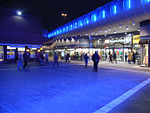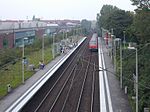Musiktheater im Revier
Ballet venuesBuildings and structures in GelsenkirchenHeritage sites in North Rhine-WestphaliaModernist architecture in GermanyMusic venues completed in 1959 ... and 4 more
Opera houses in GermanyPages containing links to subscription-only contentTheatres completed in 1959Theatres in North Rhine-Westphalia

Musiktheater im Revier (MiR) (Music Theatre in the Ruhr) is the venue for performing opera, operetta, musical theatre and ballet in Gelsenkirchen, Germany. It opened on 15 December 1959; it is listed since 1997 as a protected cultural monument. The building offers two performance spaces: the Large House (Großes Haus) with 1,008 seats and about 200 performances per year, and the Small House (Kleines Haus) with 336 seats and about 120 annual performances. In contrast to the building's outside cubic appearance, the auditoria use a more curved design.
Excerpt from the Wikipedia article Musiktheater im Revier (License: CC BY-SA 3.0, Authors, Images).Musiktheater im Revier
Kennedyplatz, Gelsenkirchen Schalke (Gelsenkirchen-Mitte)
Geographical coordinates (GPS) Address Phone number Website External links Nearby Places Show on map
Geographical coordinates (GPS)
| Latitude | Longitude |
|---|---|
| N 51.514166666667 ° | E 7.0911111111111 ° |
Address
Musiktheater im Revier
Kennedyplatz 1
45881 Gelsenkirchen, Schalke (Gelsenkirchen-Mitte)
North Rhine-Westphalia, Germany
Open on Google Maps










